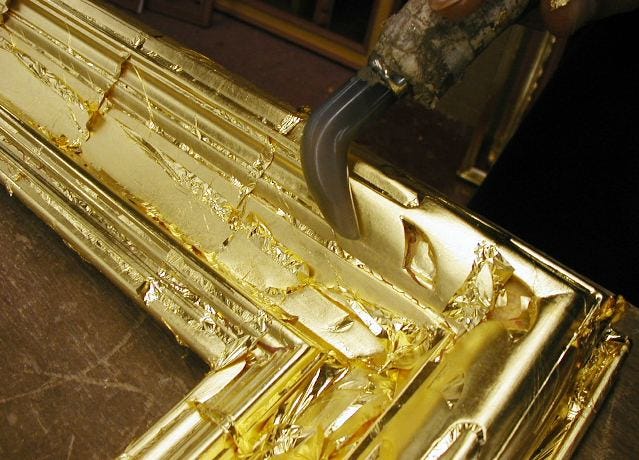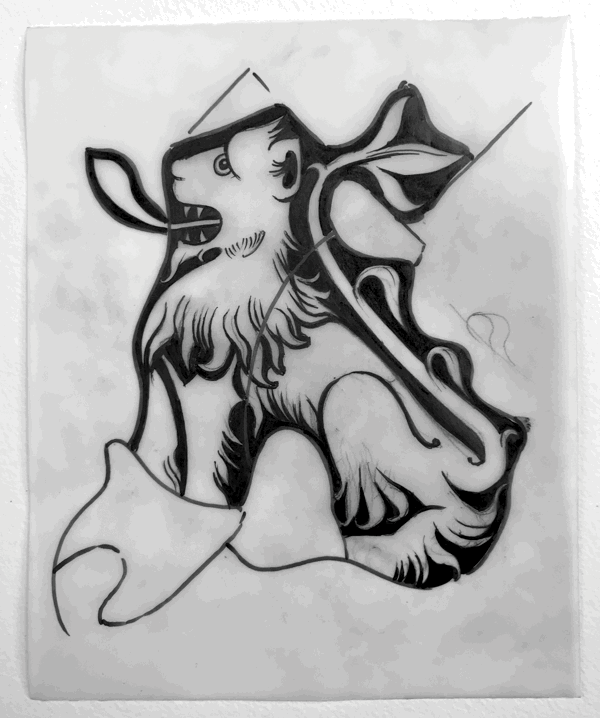First the process, second the backstory, and then we’ll talk about the why.
The process
The sea-horse you see above:
You apply a wash of paint, and blend. (“Paint mixed with what?” you ask: good question - we’ll get there soon.)
You wait several hours - this depends on how warm and dry your work-place is - then copy-trace. That is, you put your glass on top of the design and you trace the main lines onto your glass.
The tracing finished, you can immediately strengthen your lines and embolden some of them - that is, make some of them thicker than others.
You wait a few hours for this paint to dry, then you cut the highlights, and soften them by hand or use a scrub.
For shadows, you can immediately apply a wash or indeed some wide lines of tone, and blend.
You wait several hours for the paint to dry, then you reinstate old highlights or cut new ones.
Then you fire - just once.
And yes, there is a lot of waiting. But it’s not a problem when you have five or 10 bits of glass you’re painting. By the time you’ve done the last one, you can return to the first. The main challenge is actually the liquid you mix the paint with.
It isn’t water and gum Arabic.
It isn’t glycol.
It isn’t Lavender or Oil of Tar.
When using this liquid whose name we'll tell you in a moment, it’s a good idea to wear a mask. It frankly takes a lot for us to wear masks. But, when working with this liquid, we often do.
The backstory
So two months ago we spent a whole morning looking for two bits of glass Stephen painted six years ago when a client had asked us to undertake a demanding forgery of four pieces from a window which a vandal threw a brick at.
The bits of glass we sought were just the usual tests we always do before the actual work. You may imagine that in our studio there are tens of boxes filled with glass-experiments of every kind:
Different techniques.
Different paints.
Different media we mixed our paint with.
The upstairs walk-in cupboards are crammed with boxes. Thus the morning’s search.
But in the end we found the two bits painted glass we wanted. One of them you see above: the sea-horse. It wasn’t connected with the client’s window except for the liquid which we’d mixed the paint with.
All that waiting time, right?
Well, this liquid was suggested to us by an entry in an old Victorian journal Stephen owns: a long-forgotten painter, Nathaniel Somers, dissolved Shellac (a kind of resin) in warm Linseed Oil, then combined it with his glass paint, and worked according to the steps we gave you earlier.
Now next door to us there works a gilder. And when we mentioned this Victorian recipe to our next-door gilder, he suggested we experiment with the ‘glue’ - the correct term is gold size - he uses to stick gold leaf to wood or metal:
And that’s what we did: we mixed our paint with a particular gold size which remains ‘open’ (i.e. doesn’t dry) for about 3 hours.
For the sea-horse, we then went one step further, because a gilder doesn’t fire his work. (A gilder doesn’t need to. Gold leaf is metal: when the glue dries, the leaf bonds securely to the surface.) But of course we fired ours.
And as you see above, the results were promising - all those layers on top of one another, without causing harm to the layers underneath.
That’s why, back in 2011, we used the same technique for our client’s vandal-damaged stained-glass window. You see, if the end-result is what we want, we’re OK to change the process, because otherwise it gets boring - always doing things the same way, time and time again.
Besides, you never know when a skill might actually prove useful.
Like now ...
The why
The Why - as in “Why did we spend a morning hunting for the glass?” - is: because there are situations when ancient glass paint deteriorates.
Yes, sometimes the fired paint just fails.
And you can’t re-paint it and fire it again, for all kinds of good reasons.
So what can you do instead?
Well, one way to restore its appearance is by painting on the back, and leaving it unfired:
You need a glue to mix your paint with which is very strong and yet not permanent.
This liquid must be capable of all kinds of lines and shadows.
The back must be protected in various ways or else that paint will also fail.
Enter gold size for a second time. Because you’ll remember we looked long and hard for two bits of glass I painted those 6 years ago.
The first was the fired sea-horse we’ve now discussed - the experiment we fired.
The second was a crown which, just by way of investigating the effect and seeing just how tough the "glue" was, we’d painted on the back and left unfired - it’s a fragment from a window we rescued a long time ago. And for sure, from behind, it all looks somewhat rough and unattractive:
But behind is not where you mostly see it from. The crown actually looks very good in front. Not perfect. But you can “read” it, as we say, which you couldn’t do before:
Also, you can rub very, very hard at the unfired gold size paint behind, and it’s difficult to damage it. (We even soaked it in water and scrubbed it with a brush: the unfired gold size paint still put up a fight.)
Protected, the unfired gold size paint will last for ages: gold size paint is considerably more robust than glass paint mixed with water and gum Arabic. And this is a method which we’re using now for real. As I said, it pays to learn before you must.
In great summary:
You mix paint and gold size and prepare a small mound of thick paste. (Only a small mound because, remember, this gold size cures in three hours.)
As you work, you use white spirit / mineral thinner to dilute your paste to the consistency you need for whichever technique you have in hand - undercoat, copy-trace, strengthen, or flood.
The mask is beneficial because of the vapours emanating from the mineral thinner.
P.S. When you use this unfired back-painting method for restoration, there are a hundred details to consider which we won’t go into here, and of course, you can’t just jump straight in and do it. After all, the paint has faded, which means it’s difficult to see the image, like this inscription here:
That’s why you usually re-draw the image onto tracing paper first: you reconstruct it from the ghost-lines which remain. So here’s a drawing David prepared for a lion on one of the windows we’re working on right now:
When the time comes, he’ll be fun to paint.
First, though, David will finish all the drawings - the windows are full of images like him - before we don our bothersome masks and once more paint with gold size.
More on gold size here:











